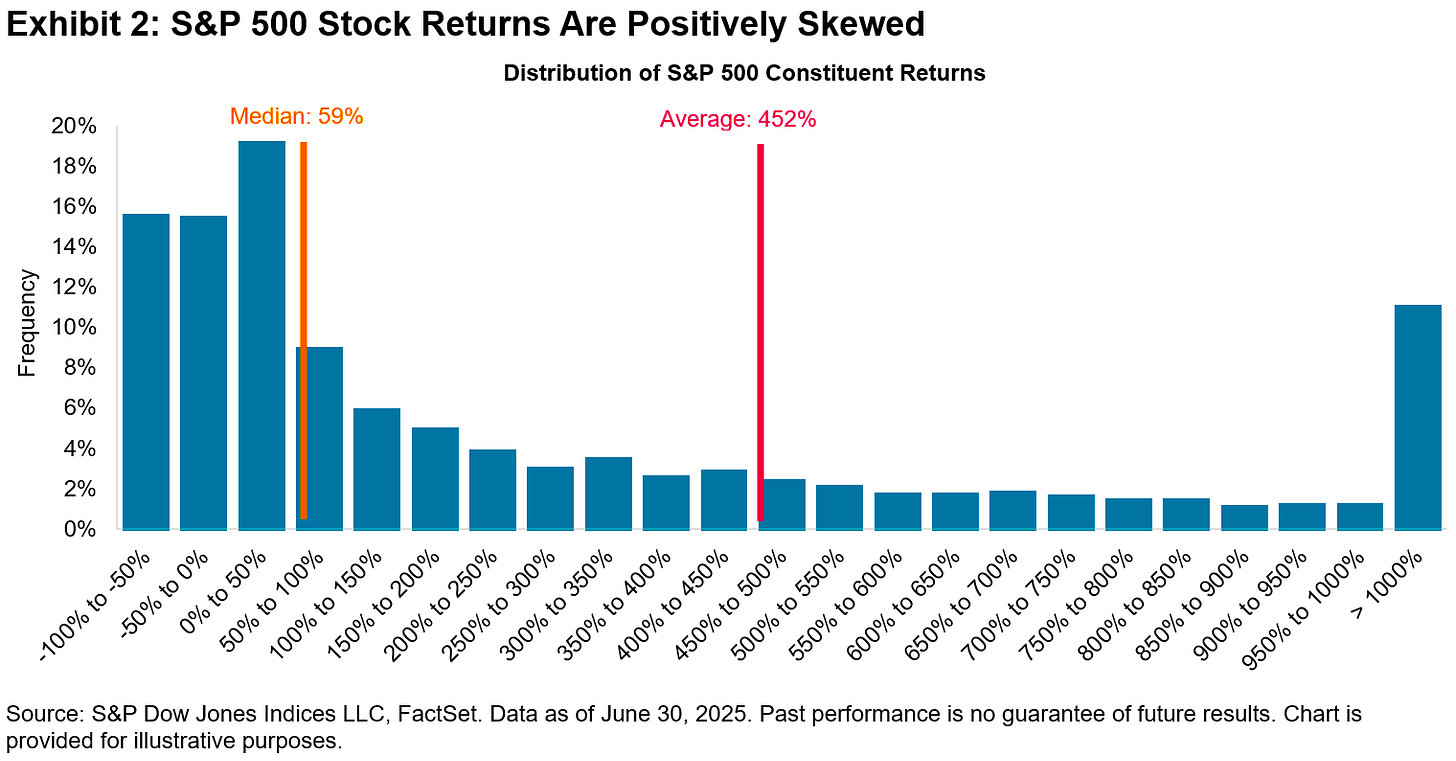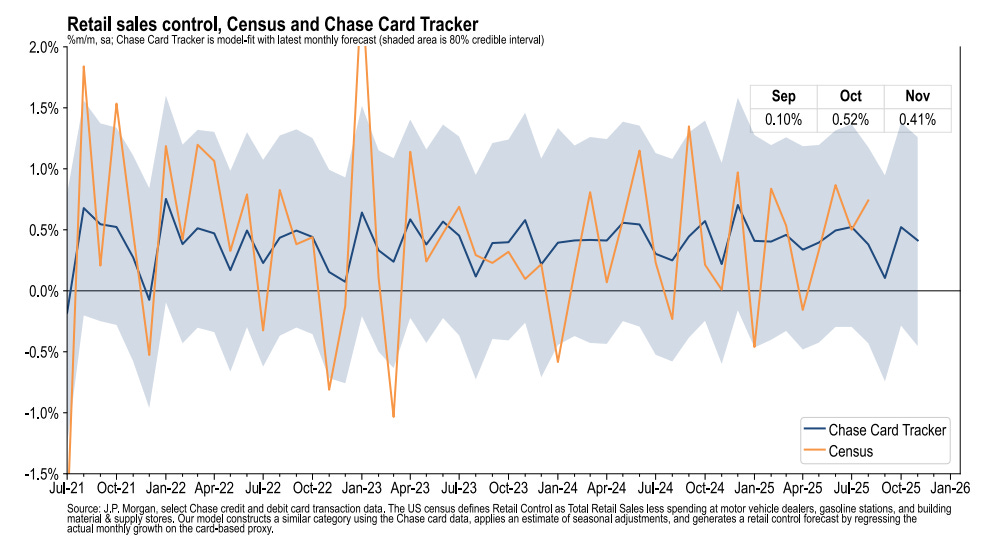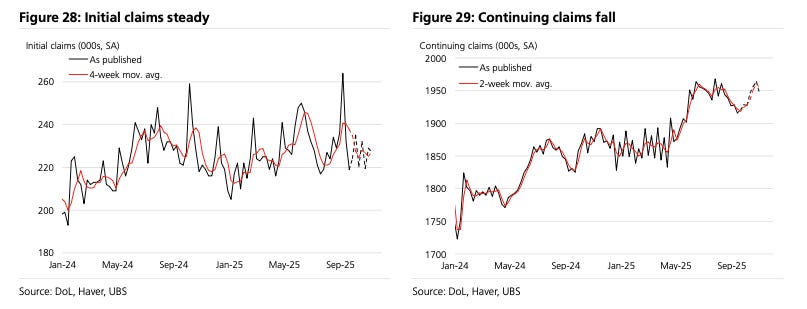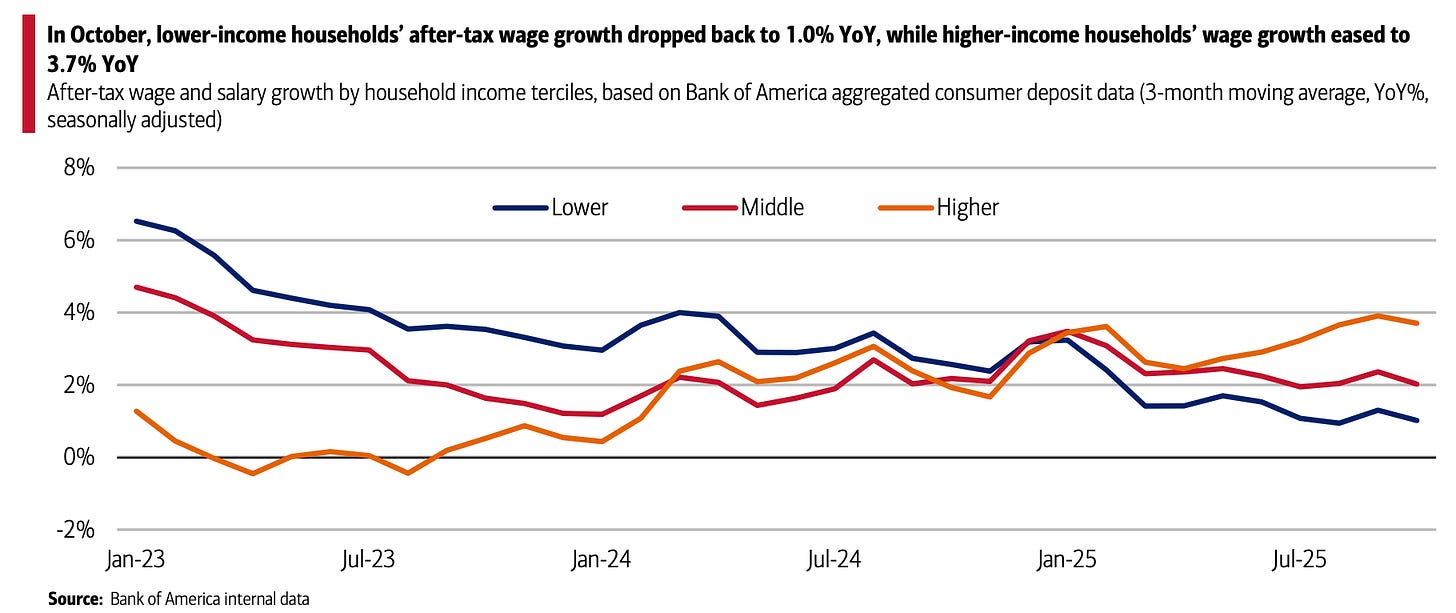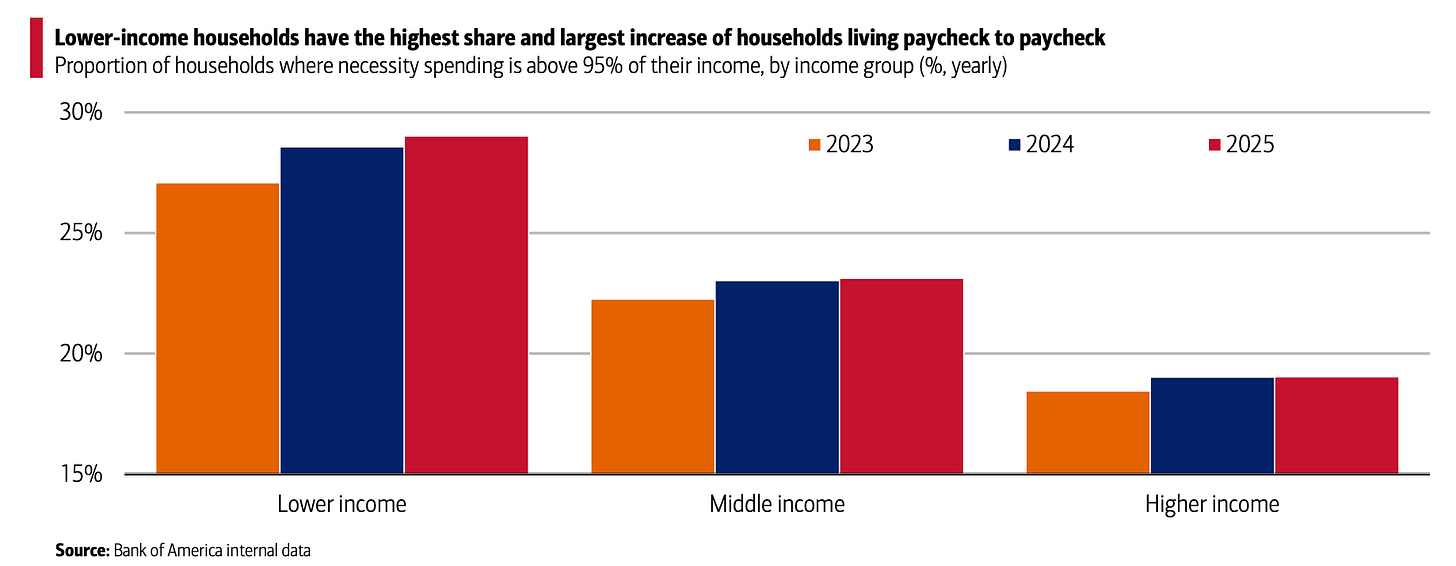Warren Buffett on luck and not beating yourself up over mistakes 🍀🤦🏻♂️
Plus a charted review of the macro crosscurrents 🔀
📈The stock market climbed last week, with the S&P 500 rising 0.1% to close at 6,734.11. The index is now down 2.3% from its Oct. 29 closing high of 6,890.89 and up 14.5% year-to-date. For more on recent market moves, read: The stock market and the economy are diverging 📊
-
Warren Buffett’s success in building a market-beating portfolio of stocks has earned him an almost mythological status in investing lore.
While it is true that the equity portfolio of his company, Berkshire Hathaway, has produced impressive returns over the years, Buffett has often shied away from the perception that he’s clairvoyant at picking winning stocks and at the right time.
Sure, he does rigorous fundamental analysis to identify great businesses to invest in. But more than most other prominent investors, Buffett emphasizes the role of luck in his successes and also the many mistakes he’s made along the way.
I was reminded of this when I read the letter he wrote on Monday to Berkshire shareholders.
His brief, eight-page message mentioned “luck” 12 times — mostly in the context of how it has affected his personal life and relationships.
“I was born in 1930, healthy, reasonably intelligent, white, male, and in America,” Buffett quipped. “Wow! Thank you, Lady Luck.“
For years, he’s referred to this advantage as winning the “ovarian lottery.”
Luck also plays a role in picking stocks. Because investing is an odd exercise where you aim to pick winners, most picks often turn out to be losers, but the few winners have the potential to produce such extraordinary performance that your whole portfolio delivers market-beating returns.
This is something Buffett discussed in his 2023 annual letter to shareholders.
“Over the years, I have made many mistakes,” he wrote. “Our satisfactory results have been the product of about a dozen truly good decisions — that would be about one every five years.“
At the time, he walked through examples, including Coca-Cola and American Express, which multiplied in value many times over while also returning massive cash dividends. Read more about it here.
This is a critical insight for investors. Because even the most successful investors make many mistakes. And market-beating portfolios often include more underperformers than outperformers.
The big picture 🖼️
People love hearing from Buffett because, despite being a billionaire, his insights on both life and investing are very relatable.
In life and investing, there are many things beyond our control. As such, many things will happen that are no fault of our own. It’s just good or bad luck. (Read more about how luck affected my career here.)
And along the way, we will make the a lot of mistakes. Even the most accomplished experts across fields make a lot of mistakes. But that is just part of the process.
In fact, Buffett’s decision to not sell his stake in Berkshire Hathaway in 1964 when it was a textile company was something he’s called a “monumentally stupid decision.” That business eventually failed. (And yet he kept the company’s name.)
“I’m happy to say I feel better about the second half of my life than the first,” Buffett wrote on Monday. “My advice: Don’t beat yourself up over past mistakes — learn at least a little from them and move on.”
You can read Buffett’s final letter to Berkshire Hathaway shareholders here.
-
Related from TKer:
Warren Buffett reminds us how picking winning stocks is hard 🤓
What Warren Buffett said about the so-called ‘Buffett Indicator’ 🧐
Review of the macro crosscurrents 🔀
There were several notable data points and macroeconomic developments since our last review:
🚨Due to the government shutdown, economic data from federal agencies has been delayed. With the government reopening, we’re slowly getting this official data, but on a significant lag. Until that data is released on its normal timely schedule, we’ll be leaning more on private sources of data.
💳 Card spending data is holding up. From BofA: “In October, total credit and debit card spending per household recorded the largest year-over-year (YoY) jump since February 2024, up 2.4% YoY, compared to 2.0% YoY in September, according to Bank of America aggregated card data. Seasonally adjusted (SA) spending growth per household increased 0.3% month-over-month (MoM), continuing a solid run of increases over the past five months.”
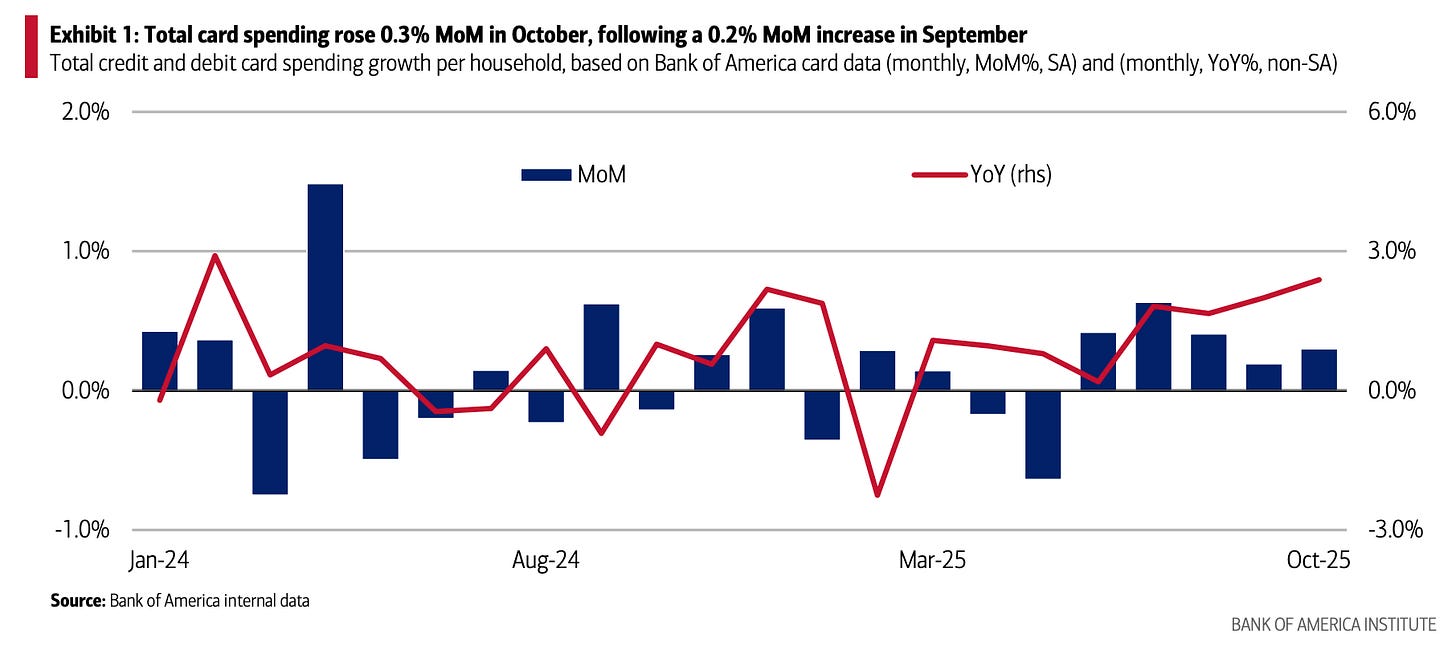
From JPMorgan: “As of 07 Nov 2025, our Chase Consumer Card spending data (unadjusted) was 5.5% above the same day last year. Based on the Chase Consumer Card data through 07 Nov 2025, our estimate of the US Census September control measure of retail sales m/m is 0.10%.”
For more on economic activity, read: 9 once-hot economic charts that cooled 📉 and We’re at an economic tipping point ⚖️
💼 Estimated new unemployment claims hold steady, total continuing claims remain elevated. While the Department of Labor is not publishing unemployment claims reports, economists are estimating national numbers using state-level reports. From UBS: “We estimate initial claims for unemployment insurance were steady in the week ending November 8, down 2K to 227K. The 4-week moving average rose 2K to 227K. Initial claims are currently not historically elevated, but they are not historically low, either. … We estimate that continuing claims for unemployment insurance fell back in the week ending November 1, down 18K to 1945K. Continuing claims mounted in the last two weeks of October and now sit roughly at the level the week ending October 11. Still, continuing claims are up 18K over four weeks, and the 2-week moving average of continuing claims sits 78K above its level last year."
Low initial claims confirm suggest layoff activity remains low. Elevated continued claims confirm hiring activity is weakening. This dynamic warrants close attention, as it reflects a deteriorating labor market.
For more context, read: The hiring situation 🧩 and The labor market is cooling 💼
👎 Job growth has turned negative. According to payroll processor ADP, private U.S. employers shed 11,250 jobs in the four weeks ending Oct. 25.
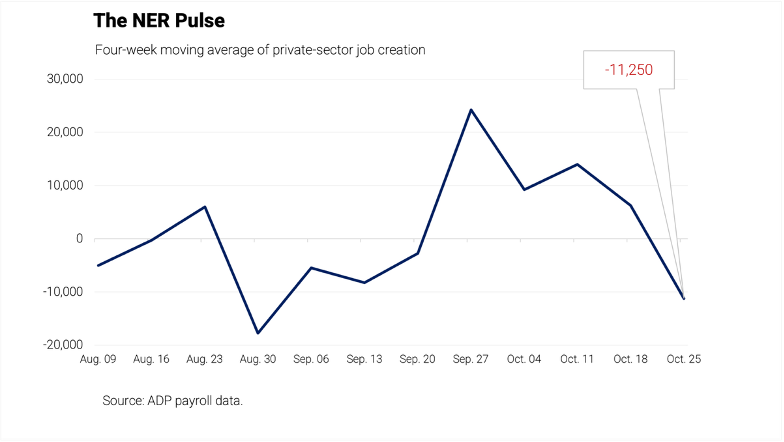
For more on what the private data providers are saying about jobs, read: The unofficial jobs data is unambiguously discouraging 💼
🚂 Freight traffic and volumes are down. Here’s Renaissance Macro’s Neil Dutta on AAR rail traffic data: “Freight activity appears to be cooling. Intermodal railcar loadings are off 8.7% year-over-year for the week ending November 8. Probably not the best sign for industrial activity in Q4.”
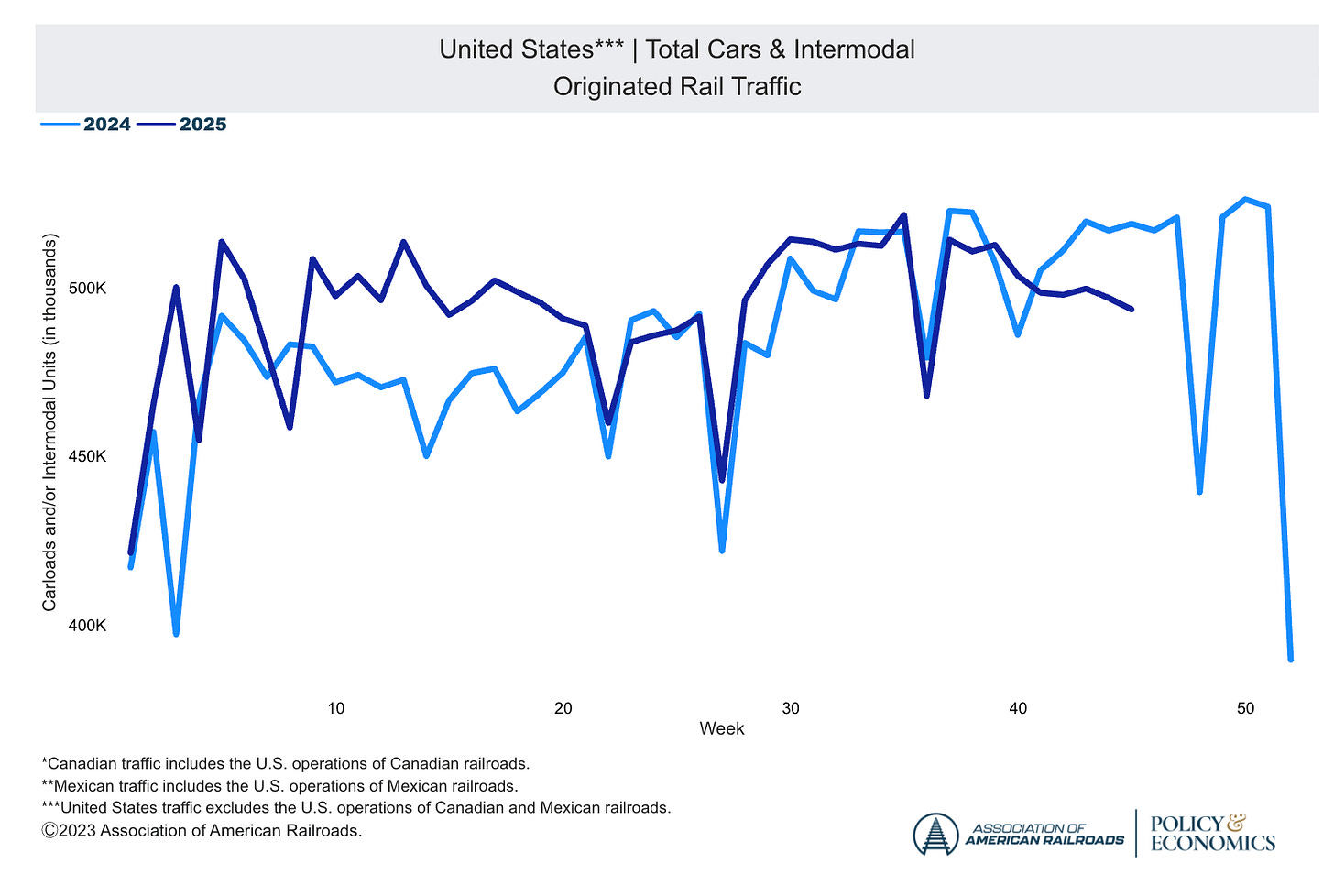
Here’s Dutta on the Cass Freight Index: “Cass Freight Index slid 2% in October, a sign of an ongoing freight recession. This index includes all domestic freight modes and is derived from $25 billion in freight transactions processed by Cass annually on behalf of its client base of hundreds of large shippers.“

For more on economic activity, read: We’re at an economic tipping point ⚖️ and 4 sometimes-conflicting ways I’m thinking about the economy 😬😞😎🙃
👎 Small business optimism ticks lower. The NFIB’s Small Business Optimism Index declined to 98.2 in October from 98.8 in September. From the NFIB: “Optimism among small businesses declined slightly in October as owners report lower sales and reduced profits. Additionally, many firms are still navigating a labor shortage and want to hire but are having difficulty doing so, with labor quality being the top issue for Main Street.”
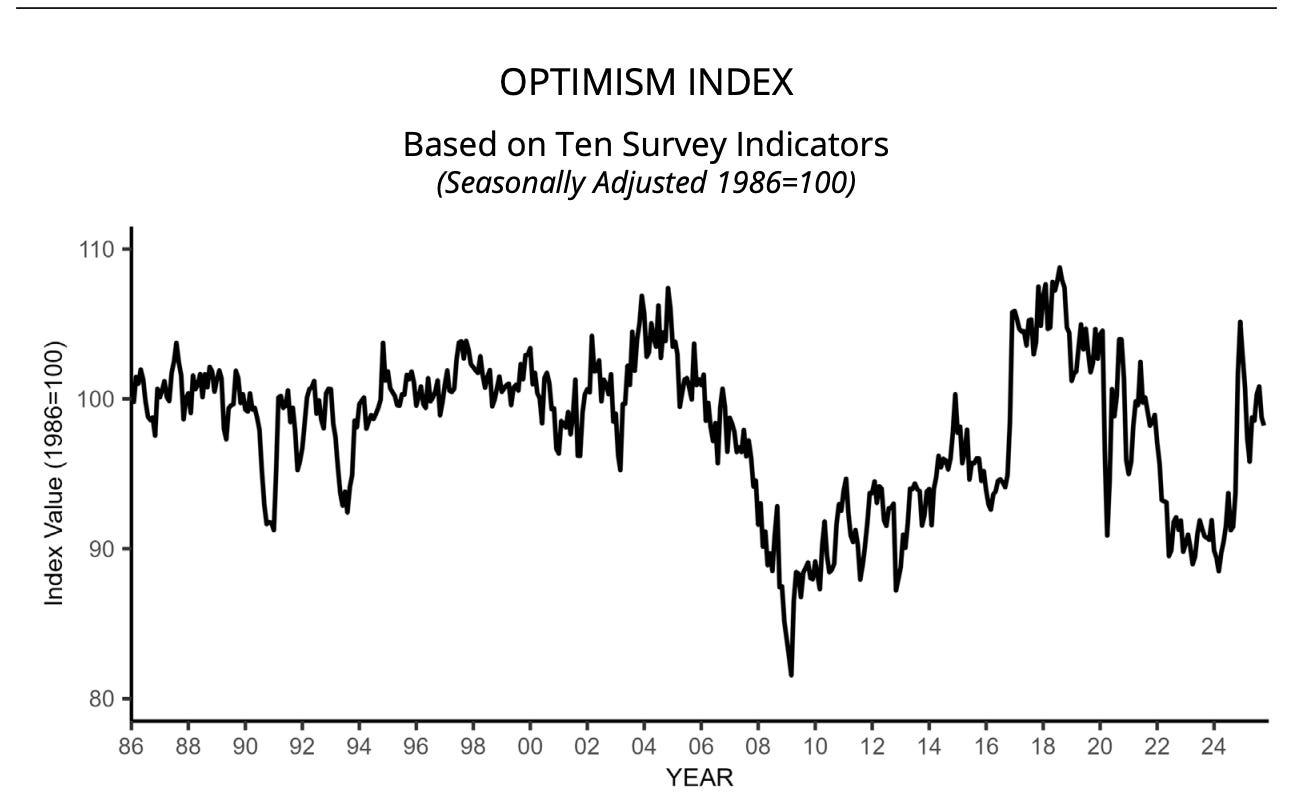
Small businesses’ plans to hire in the next three months and net unfilled job openings have been trending lower.
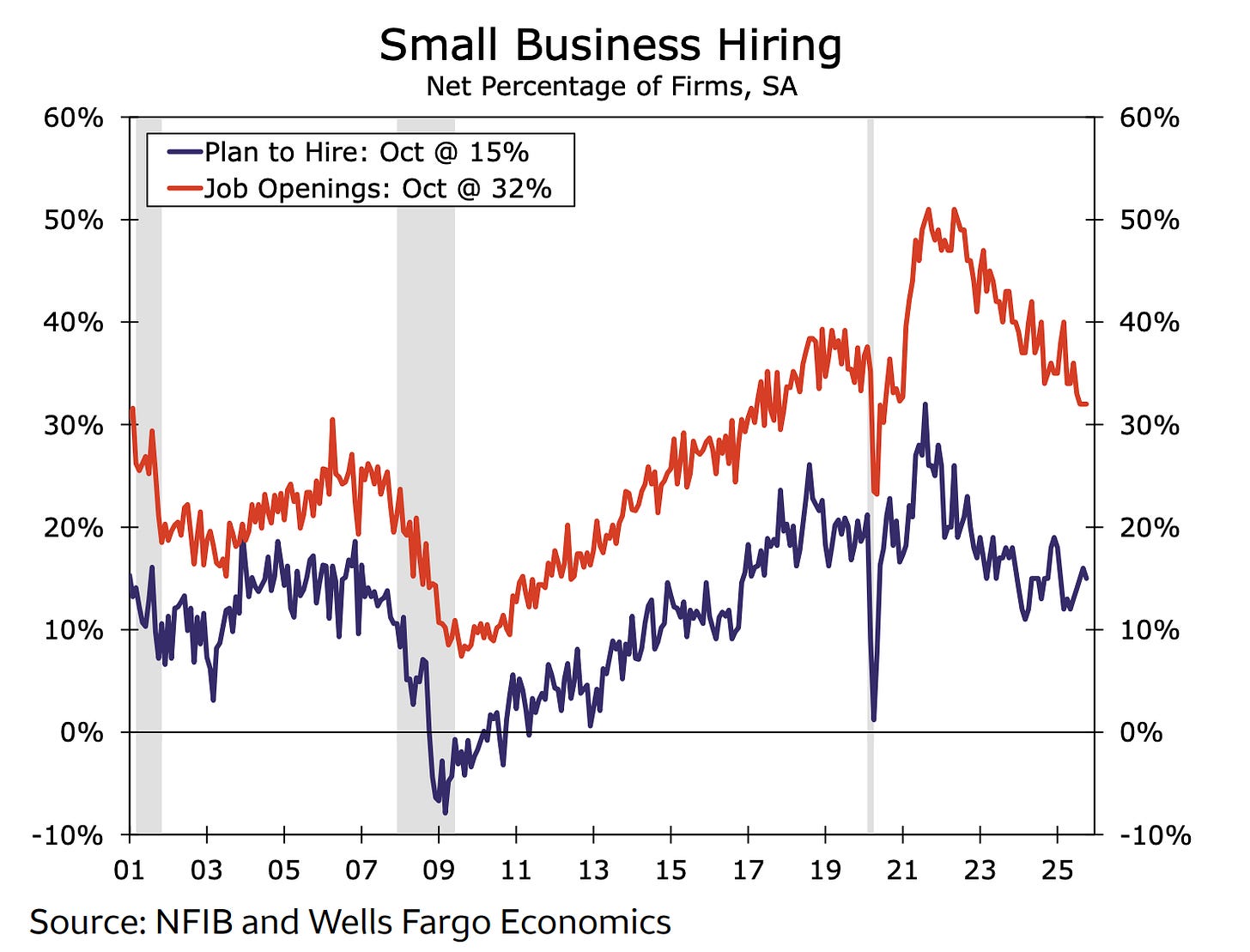
Keep in mind that during times of perceived stress, soft survey data tends to be more exaggerated than actual hard data.
For more on this, read: What businesses do > what businesses say 🙊 and 4 sometimes-conflicting ways I’m thinking about the economy 😬😞😎🙃
💰 Low-income households are increasingly challenged. From BofA: “In October, wage growth showed signs of softening, according to Bank of America internal data. After-tax earnings for lower-income households rose just 1.0% year-over-year (YoY), compared to 2.0% for middle-income and 3.7% for higher-income groups. As a result, the wage growth gap between higher- and lower-income households remains pronounced. In fact, the 2.7 percentage point (pp) difference in October matches the level seen in August 2025 – the highest since this data series began in 2016.“
More from BofA: “In 2025, 29% of lower-income households are living paycheck to paycheck – up from both last year and 2023. Meanwhile, the share of middle- and higher-income households living paycheck to paycheck has barely budged.“
For more on the K-shaped economic narrative, read: The economy may not be working for everyone right now, but it’s at least working for stock market investors 🎭
🏠 Mortgage rates tick higher. According to Freddie Mac, the average 30-year fixed-rate mortgage rose to 6.24%, up from 6.22% last week: “Rates for the 30-year and the 15-year fixed-rate mortgage essentially remained flat this week, but purchase activity increased, which is encouraging.”
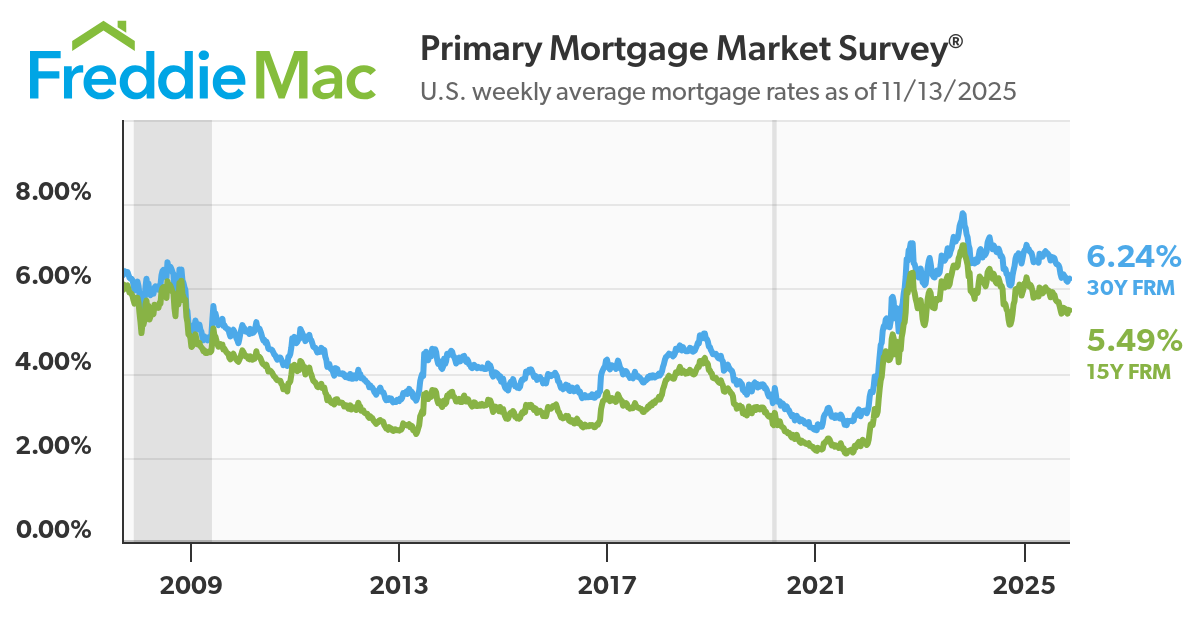
As of the summer, there were 147.9 million housing units in the U.S., of which 86.1 million were owner-occupied and about 39% were mortgage-free. Of those carrying mortgage debt, almost all have fixed-rate mortgages, and most of those mortgages have rates that were locked in before rates surged from 2021 lows. All of this is to say: Most homeowners are not particularly sensitive to the small weekly movements in home prices or mortgage rates.
For more on mortgages and home prices, read: Why home prices and rents are creating all sorts of confusion about inflation 😖
Putting it all together 📋
🚨 The Trump administration’s pursuit of tariffs is disrupting global trade, with significant implications for the U.S. economy, corporate earnings, and the stock market. Furthermore, the absence of economic data from federal agencies due to the government shutdown has made it more challenging to read the economy. Until we get more clarity, here’s where things stand:
Earnings look bullish: The long-term outlook for the stock market remains favorable, bolstered by expectations for years of earnings growth. And earnings are the most important driver of stock prices.
Demand is positive: Demand for goods and services remains positive, supported by healthy consumer and business balance sheets. Job creation, although cooling, appears to be modestly positive, and the Federal Reserve — having resolved the inflation crisis — shifted its focus toward supporting the labor market.
But growth is cooling: While the economy remains healthy, growth has normalized from much hotter levels earlier in the cycle. The economy is less “coiled” these days as major tailwinds like excess job openings and core capex orders have faded. It has become harder to argue that growth is destiny.
Actions speak louder than words: We are in an odd period, given that the hard economic data decoupled from the soft sentiment-oriented data. Consumer and business sentiment has been relatively poor, even as tangible consumer and business activity continues to grow and trend at record levels. From an investor’s perspective, what matters is that the hard economic data continues to hold up.
Stocks are not the economy: There’s a case to be made that the U.S. stock market could outperform the U.S. economy in the near term, thanks largely to positive operating leverage. Since the pandemic, companies have aggressively adjusted their cost structures. This came with strategic layoffs and investment in new equipment, including hardware powered by AI. These moves are resulting in positive operating leverage, which means a modest amount of sales growth — in the cooling economy — is translating to robust earnings growth.
Mind the ever-present risks: Of course, we should not get complacent. There will always be risks to worry about, such as U.S. political uncertainty, geopolitical turmoil, energy price volatility, and cyber attacks. There are also the dreaded unknowns. Any of these risks can flare up and spark short-term volatility in the markets.
Investing is never a smooth ride: There’s also the harsh reality that economic recessions and bear markets are developments that all long-term investors should expect as they build wealth in the markets. Always keep your stock market seat belts fastened.
Think long-term: For now, there’s no reason to believe there’ll be a challenge that the economy and the markets won’t be able to overcome over time. The long game remains undefeated, and it’s a streak that long-term investors can expect to continue.
For more on how the macro story is evolving, check out the previous review of the macro crosscurrents. »
Key insights about the stock market 📈
Here’s a roundup of some of TKer’s most talked-about paid and free newsletters about the stock market. All of the headlines are hyperlinked to the archived pieces.
10 truths about the stock market 📈
The stock market can be an intimidating place: It’s real money on the line, there’s an overwhelming amount of information, and people have lost fortunes in it very quickly. But it’s also a place where thoughtful investors have long accumulated a lot of wealth. The primary difference between those two outlooks is related to misconceptions about the stock market that can lead people to make poor investment decisions.
The makeup of the S&P 500 is constantly changing 🔀
Passive investing is a concept usually associated with buying and holding a fund that tracks an index. And no passive investment strategy has attracted as much attention as buying an S&P 500 index fund. However, the S&P 500 — an index of 500 of the largest U.S. companies — is anything but a static set of 500 stocks.

The key driver of stock prices: Earnings💰
For investors, anything you can ever learn about a company matters only if it also tells you something about earnings. That’s because long-term moves in a stock can ultimately be explained by the underlying company’s earnings, expectations for earnings, and uncertainty about those expectations for earnings. Over time, the relationship between stock prices and earnings has a very tight statistical relationship.

Stomach-churning stock market sell-offs are normal🎢
Investors should always be mentally prepared for some big sell-offs in the stock market. It’s part of the deal when you invest in an asset class that is sensitive to the constant flow of good and bad news. Since 1950, the S&P 500 has seen an average annual max drawdown (i.e., the biggest intra-year sell-off) of 14%.
How the stock market performed around recessions 📉📈
Every recession in history was different. And the range of stock performance around them varied greatly. There are two things worth noting. First, recessions have always been accompanied by a significant drawdown in stock prices. Second, the stock market bottomed and inflected upward long before recessions ended.

In the stock market, time pays ⏳
Since 1928, the S&P 500 has generated a positive total return more than 89% of the time over all five-year periods. Those are pretty good odds. When you extend the timeframe to 20 years, you’ll see that there’s never been a period where the S&P 500 didn’t generate a positive return.

What a strong dollar means for stocks 👑
While a strong dollar may be great news for Americans vacationing abroad and U.S. businesses importing goods from overseas, it’s a headwind for multinational U.S.-based corporations doing business in non-U.S. markets.

Stanley Druckenmiller's No. 1 piece of advice for novice investors 🧐
…you don't want to buy them when earnings are great, because what are they doing when their earnings are great? They go out and expand capacity. Three or four years later, there's overcapacity and they're losing money. What about when they're losing money? Well, then they’ve stopped building capacity. So three or four years later, capacity will have shrunk and their profit margins will be way up. So, you always have to sort of imagine the world the way it's going to be in 18 to 24 months as opposed to now. If you buy it now, you're buying into every single fad every single moment. Whereas if you envision the future, you're trying to imagine how that might be reflected differently in security prices.
Peter Lynch made a remarkably prescient market observation in 1994 🎯
Some event will come out of left field, and the market will go down, or the market will go up. Volatility will occur. Markets will continue to have these ups and downs. … Basic corporate profits have grown about 8% a year historically. So, corporate profits double about every nine years. The stock market ought to double about every nine years… The next 500 points, the next 600 points — I don’t know which way they’ll go… They’ll double again in eight or nine years after that. Because profits go up 8% a year, and stocks will follow. That's all there is to it.
Warren Buffett's 'fourth law of motion' 📉
Long ago, Sir Isaac Newton gave us three laws of motion, which were the work of genius. But Sir Isaac’s talents didn’t extend to investing: He lost a bundle in the South Sea Bubble, explaining later, “I can calculate the movement of the stars, but not the madness of men.” If he had not been traumatized by this loss, Sir Isaac might well have gone on to discover the Fourth Law of Motion: For investors as a whole, returns decrease as motion increases.
Most pros can’t beat the market 🥊
According to S&P Dow Jones Indices (SPDJI), 65% of U.S. large-cap equity fund managers underperformed the S&P 500 in 2024. As you stretch the time horizon, the numbers get even more dismal. Over a three-year period, 85% underperformed. Over a 10-year period, 90% underperformed. And over a 20-year period, 92% underperformed. This 2023 performance follows 14 consecutive years in which the majority of fund managers in this category have lagged the index.
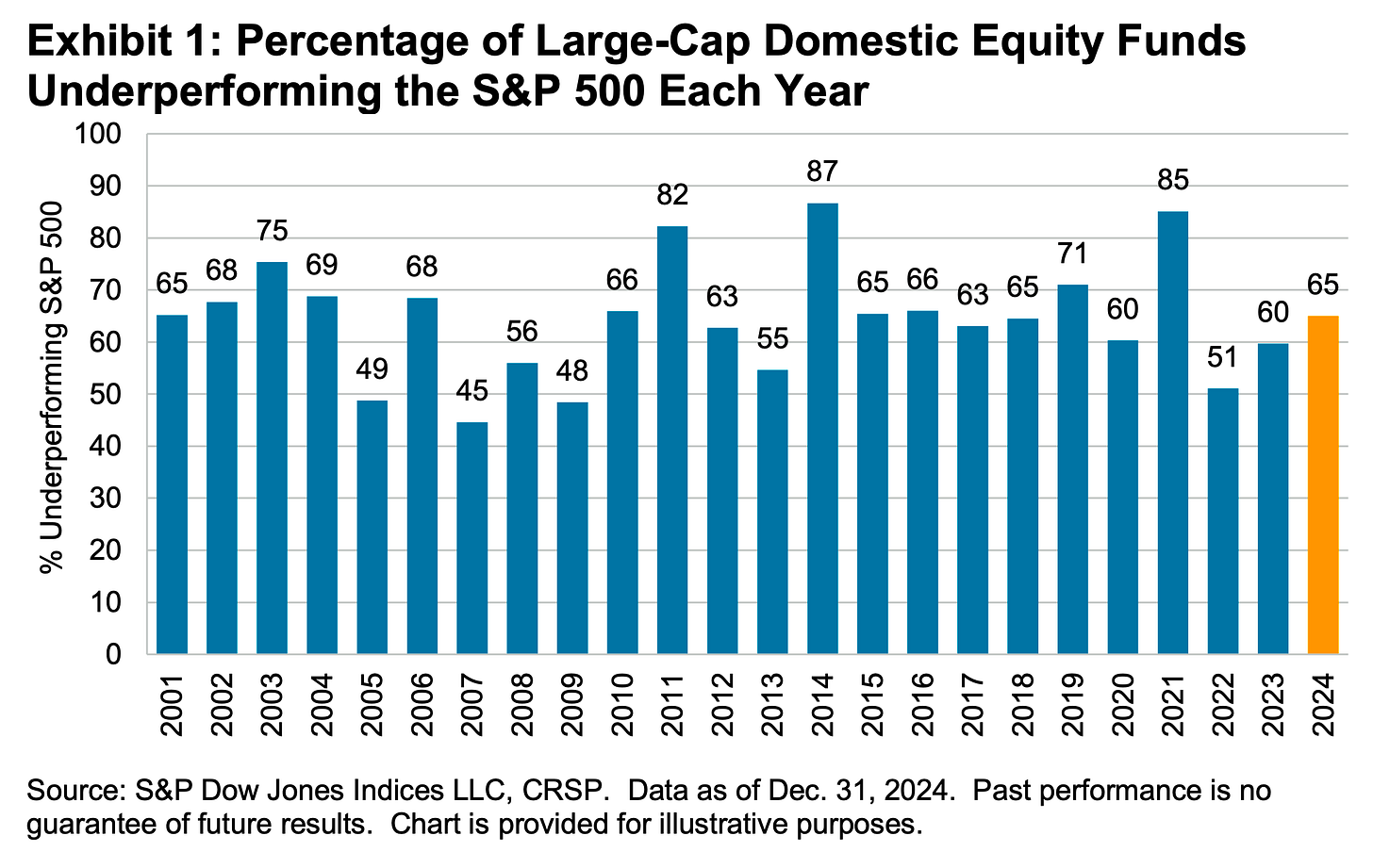
Proof that 'past performance is no guarantee of future results' 📊
Even if you are a fund manager who generated industry-leading returns in one year, history says it’s an almost insurmountable task to stay on top consistently in subsequent years. According to S&P Dow Jones Indices, just 4.21% of all U.S. equity funds in the top half of performance during the first year were able to remain in the top during the four subsequent years. Only 2.42% of U.S. large-cap funds remained in the top half
SPDJI’s report also considered fund performance relative to their benchmarks over the past three years. Of 738 U.S. large-cap equity funds tracked by SPDJI, 50.68% beat the S&P 500 in 2022. Just 5.08% beat the S&P in the two years ending 2023. And only 2.14% of the funds beat the index over the three years ending in 2024.

The odds are stacked against stock pickers 🎲
Picking stocks in an attempt to beat market averages is an incredibly challenging and sometimes money-losing effort. Most professional stock pickers aren’t able to do this consistently. One of the reasons for this is that most stocks don’t deliver above-average returns. According to S&P Dow Jones Indices, only 19% of the stocks in the S&P 500 outperformed the average stock’s return from 2001 to 2025. Over this period, the average return on an S&P 500 stock was 452%, while the median stock rose by just 59%.
